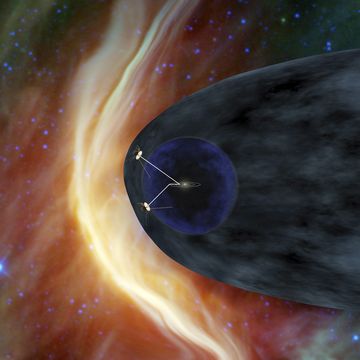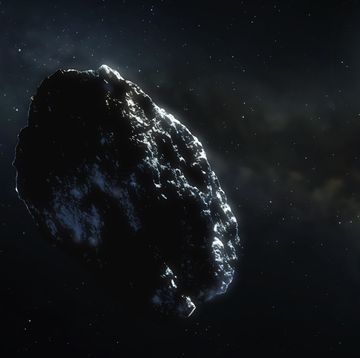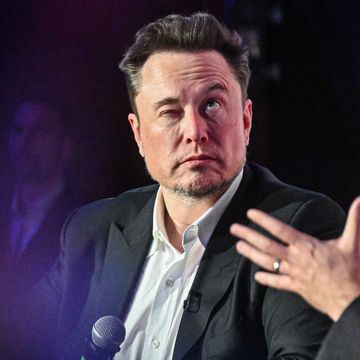Editor's Note: Today, October 31, 2014, a Virgin Galactic SpaceShipTwo crashed in the Mojave Desert, killing one pilot on board and leaving the other in critical condition. In this feature originally published on October 6, we look into why the private space race is such a difficult—and sometimes deadly—venture.
When SpaceShipOne rocketed out of the atmosphere over Mojave, California, on October 4, 2004, it reached suborbital space for the second time in less than a week and the third time that year, capturing the $10 million Ansari X Prize.
To those of us on the ground that morning, it seemed that the competition had done what X Prize founder Peter Diamandis had hoped, opening the door to commercial space travel. Not long after, Richard Branson bolstered our hopes by signing SpaceShipOne builder Scaled Composites to build a bigger craft, SpaceShipTwo, for his Virgin Galactic outfit. Branson promised that VG would soon fly paying passengers on suborbital flights, offering the chance to see the curvature of the earth and experience a few minutes of microgravity.
And here we are 10 years later, still stuck on the ground. SpaceShipOne hangs on display in the Smithsonian National Air & Space Museum in Washington, and no other craft has duplicated its achievement. In the decade since the X Prize, Scaled has completed SpaceShipTwo and its White Knight 2 mothership. And this past January, the craft completed its third rocket-powered flight. But the spaceship still hasn't reached the 62-mile Kármán line that marks the internationally accepted boundary of space.
As for Branson, his Virgin Galactic operation has been subject to repeated delays. He said last month that he now expects to inaugurate commercial service to space in February or March of 2015.
When Scale Fails
We asked Brian Binnie—who piloted the X Prize–winning flight in 2004 and remained at Scaled Composites until February 2014—why it has taken his former company and Virgin so long to get back into space.
"The delay in SpaceShipTwo has not been the development of either of the vehicles," Binnie says. "But the rocket motor has just been problematic from the get-go."
Those problems start with scale. Binnie says the company's original plan was simply to scale up the design of SpaceShipOne's motor to fit the larger SpaceShipTwo. "That sounded good to us. Our name was Scaled," Binnie says. "Basically an airframe was built betting that the propulsion system would meet the demands that the requirements [for SpaceShipTwo] offered."
Scaled Composites lost the bet. Binnie says every part of the original motor design has had to be revised from the ground up. Take the nitrous oxide tank, which had to be bigger while maintaining a high internal pressure, with the additional requirement that it hold up over the course of the many flights expected during commercial operations. In 2007, a version of the tank exploded during a ground test, killing three Scaled employees. The tank has since been completely redesigned.
The synthetic-rubber solid fuel in the motor is another problem for SpaceShipTwo. "It was full of instabilities initially," he says. "We had startup instabilities and we had end-of-burn instabilities." Even on SpaceShipOne, the uneven rate at which the solid fuel burned produced uneven thrust. That problem worsened on SpaceShipTwo. While trying to fix the problem, Binnie says, "we did everything but break down and pray to God to show us the light of day."
Since Binnie's departure, the Scaled team has switched to another type of solid fuel, a plastic that is similar to nylon. "My feeling is that the nylon motor has a lot more potential," Binnie says. "It's easier to build. The fuel maintains its structural integrity throughout the burn."
The Challengers
Back in 2004, none of the other Ansari X PRIZE competitors even came close to claiming the prize. Today, however, two other competitors for the suborbital-space-travel market are completing their own vehicles. These are Blue Origin and XCOR Aerospace.
Blue Origin, financed by Amazon CEO Jeff Bezos, is building autonomous vertical-takeoff and -landing rockets. Last month, the company announced a deal with United Launch Alliance (a rocket partnership between Boeing and Lockheed Martin) to build a new 550,000-pound-thrust rocket engine to be powered by liquefied natural gas and liquid oxygen. It will be called the BE-4. The super-secretive Blue Origin is said to be close to testing its first full-scale rocketship.
XCOR Aerospace—like Scaled Composites, based in Mojave—is building a spaceplane powered by four liquid-fuel engines. Although the company has been working on the technologies at the heart of the Lynx since its founding in 1999, it lacks the deep pockets of its competitors. So it has had to build up to spaceflight one step at a time, aided by contracts for each technological piece of the puzzle. The company hopes to launch its first test flights next year. Binnie joined XCOR in April as a test pilot.
The Market
As Virgin's customer base demonstrates (700 people and counting have put down deposits on suborbital tickets costing up to a quarter of a million dollars each), there is a market for suborbital spaceflight. NASA, too, has gotten in on the game, purchasing tickets for its researchers who for the first time will be able to make repeated flights with their microgravity experiments.
It remains to be seen just how many flights, and how many companies, the suborbital market will eventually support. For now, those in the game are betting that if they build their vehicles, people will come—especially if economies of scale drive down the price of going into space.
And remember, the suborbital market is distinct from the market for orbital spaceflight, which requires spacecraft to go faster and higher. SpaceX and Boeing recently won NASA contracts to fly astronauts to the International Space Station beginning in 2017, and both of those companies have expressed interest in eventually serving private customers. So far, a total of eight people have paid tens of millions of dollars each for flights to the space station since 2001.
Are we finally on the verge of regular commercial service to space? "If we don't see commercial flights going to space in the next five years," Binnie says, "then I don't see when it will ever happen."
Michael Belfiore is the author of Rocketeers: How a Visionary Band of Business Leaders, Engineers, and Pilots Is Boldly Privatizing Space.














